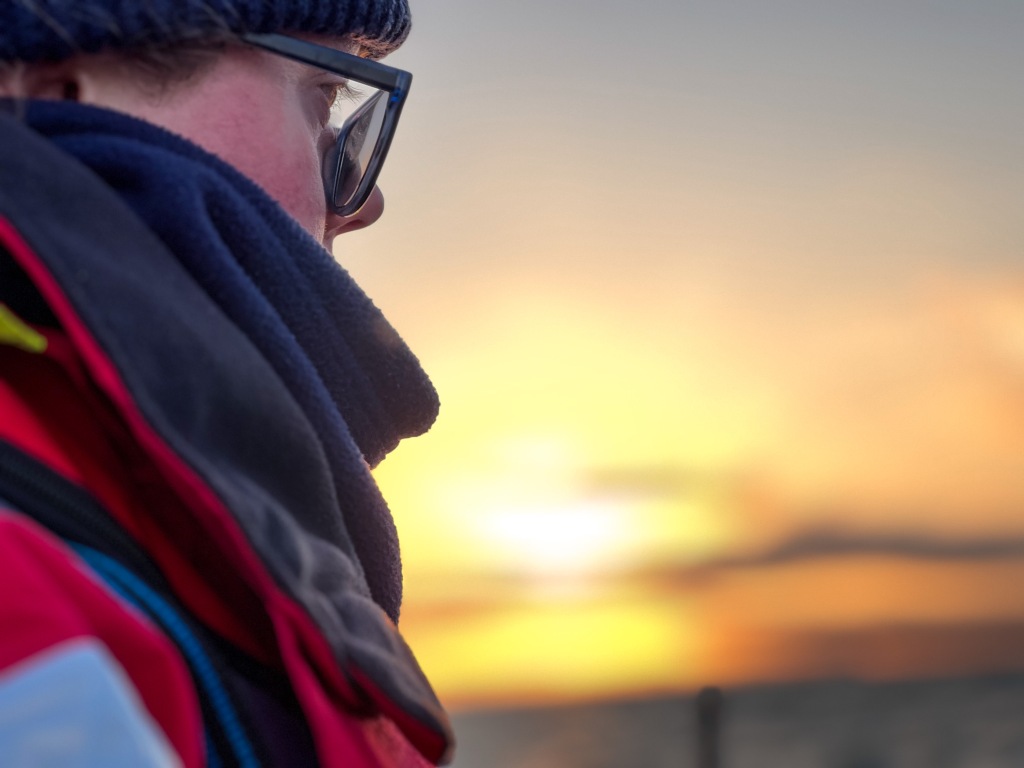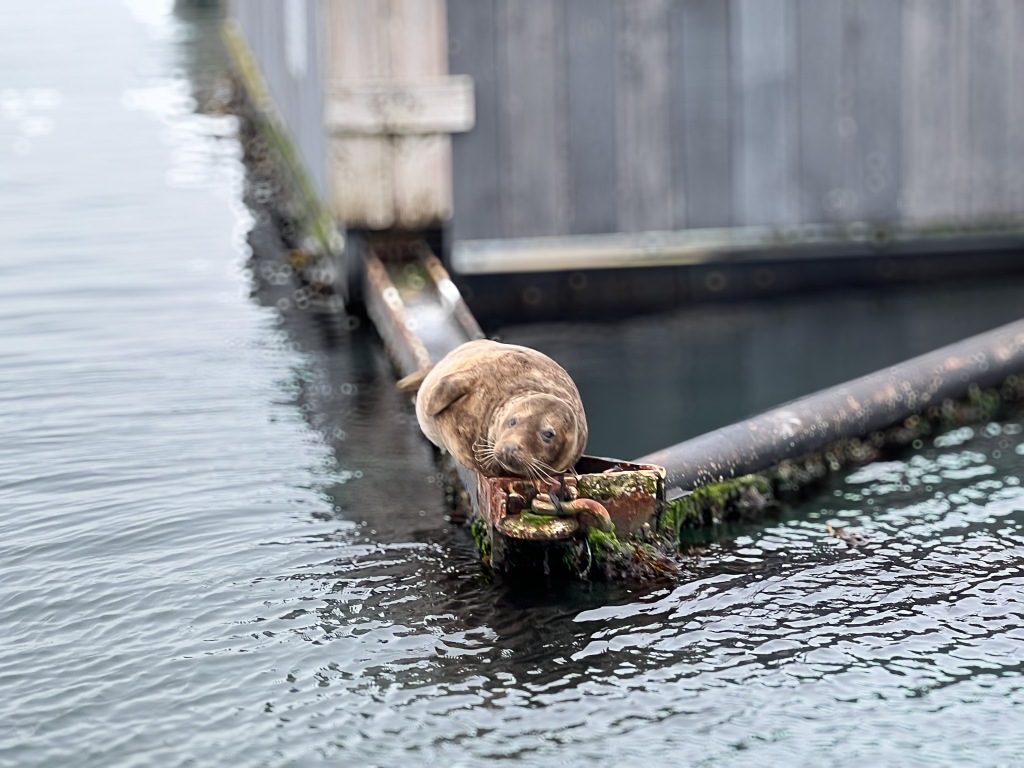A Clockwise Circumnavigation of the UK and Ireland in Gaudeo (Bowman 40)
| 08:35 Tuesday 7th April 2023 |
| Cowes to Portland |
| FAIR | F1-2 NORTH VEERING SW | SMOOTH BECOMING SLIGHT | 1017 mBar STEADY |
Our next stop would be Portland, the staging post for the sail around Portland Bill, a famous headland known for its tricky waters. Favorable winds and our timing seemed to make light work of the voyage. We’d taken the opportunity to take a breather in Cowes, and I was happy to be back out on the water. I’d like to add that while in Cowes, I tried to find the most cost-efficient marina, but nothing was actually as cheap as the Cowes Yacht Haven…

As we sailed west out of the Solent, we caught sight of the Needles. I believe that passing the Needles is a joy for any sailor, akin to seeing the white cliffs of Dover (something I didn’t mention but always revere) and the Seven Sisters. These major geographical landmarks provide a sense of place, a reassurance of recognition; your place in the world is known, and possibly, you’re nearly home. Lacking significant natural formations in Essex and Suffolk, The Naze Tower and the Felixstowe cranes serve this purpose too. In the case of Naze Tower, this is its very purpose. However, being man-made, they fail to evoke a certain wonder related to deep time. Further along the English Channel, we’d see the Jurassic Coast, where the exposed cliffs demonstrate the strata, the layering of the earth as it has developed over millennia. Of course, the Needles do this too, yet the thick layers of chalk seem to merge into one and continue to change. The stack that gives its name to the line of stacks running out from the western peninsula of the Isle of Wight stood around 120ft high; it was also known as ‘Lot’s Wife.’ Coastal erosion caused its collapse, and it was lost to the sea in 1764, with an impact that could be heard for miles. This stack was beyond the remaining rocks and now forms a reef, which is still revealed on low spring tides.



For me, Portland Lighthouse provided a similar sensation. While contemplating this, I was brought down to earth by the sound of the bilge alarm. This had become a long-standing oddity that I hadn’t been able to resolve. Before leaving Cowes, we’d filled up the water tanks (I’d previously been leaving the starboard tank empty as I suspected it had a leak). Mark immediately leaped to the ‘Ramsgate rub’ (p. 2) as the cause, but I had assumed that it was an older issue. But to reassure Mark, I tested the bilge water for salinity, but unfortunately the result was inconclusive. Then I realised I had an earlier concern about the engine’s impellor (the impellor (or impeller) is the little pump driven by the engine that pushes the seawater through the heat exchanger – the equivalent of a car’s radiator). Whilst re-sealing the impellor casing some saltwater had ended up in the bilge. So instead, whilst taking all necessary precautions I pumped all of the briny water out of the bilge.
As we sailed through the east gate of the harbour (actually we motored in, as I’m not sure that the Harbour Master would be too impressed if we had sailed in), we saw the naval ships at the far side of the enormous harbour, and we were welcomed by the resident dolphin. The marina had been given a freshen-up for the 2012 Olympics, and the facilities were still very acceptable. As we pulled into the berth, the bilge alarm sounded again, and I retested the water. As I’d suspected, it was fresh. Once again, I checked every possible source, but I couldn’t detect any leaks, yet the time between alarms was definitely reducing. I selected the suspect starboard tank as duty in order to drain it quickly.


That evening whilst checking in with the marina I discussed our sail plan to round the Bill with the Harbour Master, he recommended the inshore route and demonstrated to me how to gauge the necessary distance I’d need to be, lining up the monument with the lighthouse’s window. However, to successfully navigate his plan, we’d need to leave near midday and arrive in Brixham after dark. This would not normally be a problem. I’d sailed there before, but the crew hadn’t sailed at night, so I thought it better we crossed Lyme Bay during the day, push some tide and head south of the Shamble and well clear of the Bill’s Race. It would result in a slow sail, and it would probably call for the engine but I thought that this was the better of the two evils.
| 06:15 Saturday 8th April 2023 |
| Portland to Brixham |
| FAIR | F2-4 EAST | SLIGHT BECOMING MODERATE | 1020 mBar STEADY |

– Departing Portland at dawn

– Michelle

– Me at the chart table
Although we had the sails up and healed over nicely, as suspect, it was a long motorsail, being deficient in sufficient wind and with some tide against us, but on arrival at Brixham, we were welcomed by the harbour’s resident seal population, which was nice.

While replacing the throttle cable, I could ignore the state of the bow-thruster’s controls. Knowing how vital this had been when we lost the engine, I wanted to revamp them. Serendipitously, I’d managed to win a pair of identical bow-thruster joysticks. They’d previously been used on a motorboat in Devon, and the chap that lived nearby agreed to seal the deal in Brixham, which worked out perfectly.


Brixham provided me with the time and facilities (showers, a laundry service, and the time) to take a run. I’d started running a couple of years ago as a means to improve my fitness after a chronic period of languishing with Leukaemia. I never thought I’d enjoy running, but it’s true; I actually do. My fitness peaked a couple of years ago immediately before I was diagnosed with throat cancer. In the weeks prior, I’d run two half marathons. On the day I received the results of my neck lymph gland biopsy, I’d run 27 km (64% of a marathon) just around the neighbourhood. I have no interest in running races; I’m happy running with our dog. On this occasion, our dog was at home, so I just went running, partly to explore and partly for the mental health it seems to provide me.







Brixham is a lovely, Devonshire coastal town. Its charm lies in its picturesque setting, and rich maritime heritage. This quaint fishing town offers a perfect blend of natural beauty and cultural treasures.
The town’s bustling harbour is colourful, full of fishing boats bobbing in the sheltered harbour. The aroma of freshly caught seafood wafts through the air, tempting visitors to indulge in delicious fish and chips or sample the local delicacy, Brixham crab.
If you have an interest in history, you’ll be delighted to explore Brixham’s maritime past. The town played a significant role in the sailing and fishing industries. You can delve into its history at the Brixham Heritage Museum, where you can learn about famous voyages, view fascinating exhibits, and even step aboard replica ships to experience what life was like at sea. If you’re lucky enough, there might be an independent yacht charter boat in the marina who can take you for a sail in the bay…
Otherwise, as I partly explored on my run, the South West Coast Path offers beautiful coastal walks, allowing you to soak in panoramic views of the rugged cliffs and dramatic coastline. The area is also a haven for birdwatchers, with a variety of seabirds and migratory species calling Brixham home.
Whether you’re exploring the quaint streets, indulging in delicious seafood, or immersing yourself in the town’s fascinating history or its surrounding nature, Brixham is sure to leave a lasting impression.
Like by clicking on the symbols and / or share / subscribe below
